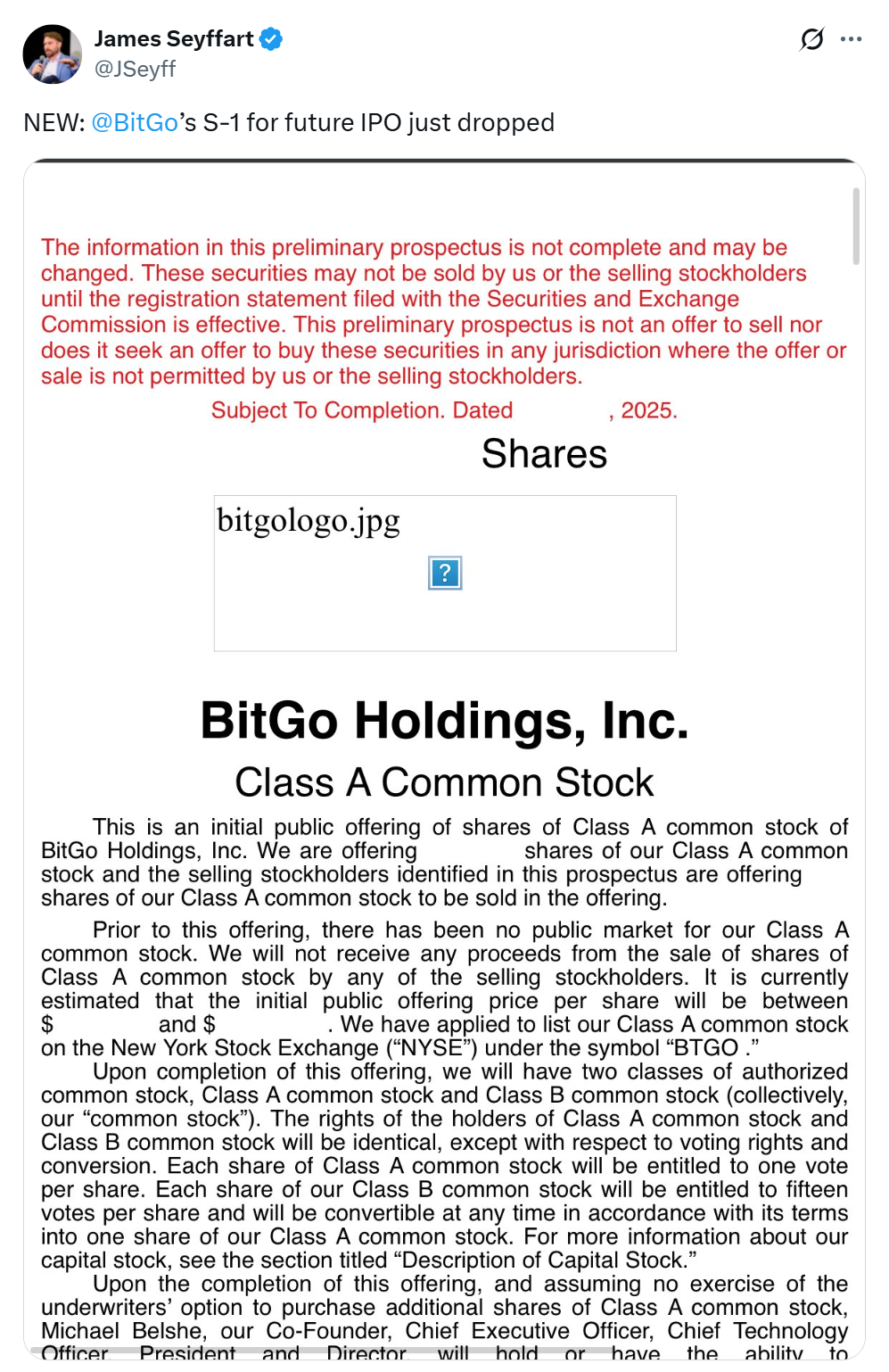BitGo has filed for a US IPO, seeking an NYSE listing under ticker BTGO and reporting $90.3 billion in assets under custody as of June 30, 2025. The filing highlights BitGo’s institutional custody scale, global client base and dual-class share structure retaining CEO control.
-
BitGo files to go public with $90.3B in assets under custody.
-
IPO targets NYSE listing under ticker BTGO; CEO retains voting control via dual-class shares.
-
BitGo serves 4,600+ institutional clients and 1.1M+ users across 100 countries; supports 1,400+ digital assets.
Meta description: BitGo IPO: BitGo files to go public with $90.3B in assets under custody, targeting NYSE listing under BTGO — learn key details and implications.
BitGo files to go public with $90.3 billion in assets under custody, aiming for an NYSE listing under the ticker BTGO as institutional crypto adoption accelerates under evolving US policy.
Crypto custody firm BitGo has filed an S‑1 registration statement with the U.S. Securities and Exchange Commission to pursue an initial public offering. The filing proposes listing Class A common stock on the New York Stock Exchange under the ticker BTGO.
BitGo reported approximately $90.3 billion in assets under custody on its platform as of June 30, 2025. The company serves more than 4,600 institutional and enterprise clients and over 1.1 million individual users across 100 countries.

BitGo files for US IPO. Source: James Seyffart
What is included in BitGo’s IPO filing?
The S‑1 details BitGo’s customer base, custody scale, insurance coverage and compliance milestones. BitGo supports over 1,400 digital assets, cites $250 million in insurance coverage, and reports completion of SOC 1 and SOC 2 audits.
How does BitGo’s governance structure work?
BitGo will operate as a controlled company under NYSE rules. Co‑founder and CEO Michael Belshe will maintain control via dual‑class shares: Class B shares carry 15 votes each, while Class A shares carry one vote. This preserves founder control over strategic direction.
Why does the filing matter for institutional crypto custody?
The IPO brings public-market transparency to a major custody provider. Institutional adoption is signaled by BitGo’s large assets under custody and broad institutional client roster. The filing may also accelerate peer activity among banks and custody providers expanding crypto services.
What regulatory and compliance highlights did BitGo cite?
BitGo reports SOC 1 and SOC 2 audits and notes a €-area regulatory milestone: its European arm secured an extended license from Germany’s Federal Financial Supervisory Authority (BaFin) to provide trading, custody, staking and transfer services under the EU’s MiCA framework.
How does this filing fit the broader market trend?
Several crypto-native and hybrid firms have pursued public listings recently, reflecting renewed investor appetite and regulatory shifts in the U.S. The filing follows announcements of traditional banks and financial institutions revisiting crypto custody offerings in 2025.
Frequently Asked Questions
When did BitGo report its assets under custody figure?
BitGo reported $90.3 billion in assets under custody as of June 30, 2025, in the S‑1 registration statement filed with the SEC.
Will BitGo’s IPO dilute founder control?
The dual‑class share structure preserves significant voting control for CEO Michael Belshe, meaning public investors will have economic ownership but limited voting influence compared with Class B holders.
Key Takeaways
- BitGo IPO filed: BitGo submitted an S‑1 to pursue an NYSE listing under the ticker BTGO.
- Scale of custody: The firm reported $90.3B in assets under custody and serves 4,600+ institutional clients.
- Governance: Dual‑class shares allow CEO Michael Belshe to retain voting control.
- Compliance signals: SOC 1/SOC 2 audits and BaFin license for EU operations bolster trust claims.
Conclusion
BitGo’s S‑1 filing positions the company as a leading institutional custody provider entering public markets, emphasizing custody scale, compliance credentials and founder control. Market participants and institutional investors will watch subsequent SEC review, pricing, and the broader implications for crypto custody and financial institutions adapting to digital‑asset demand.






